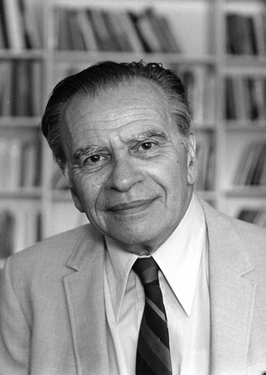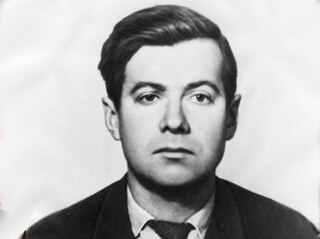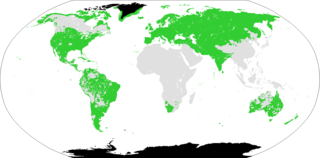
The Altaic languages consist of the Turkic, Mongolic and Tungusic language families, with some linguists including the Koreanic and Japonic families. These languages share agglutinative morphology, head-final word order and some vocabulary. The once-popular theory attributing these similarities to a common ancestry has long been rejected by most comparative linguists in favor of language contact, although it continues to be supported by a small but stable scholarly minority. Like the Uralic language family, which is named after the Ural Mountains, the group is named after the Altai mountain range in the center of Asia. The core grouping of Turkic, Mongolic and Tungusic is sometimes called "Micro-Altaic", with the expanded group including Koreanic and Japonic labelled as "Macro-Altaic" or "Transeurasian".

Joseph Harold Greenberg was an American linguist, known mainly for his work concerning linguistic typology and the genetic classification of languages.

Nostratic is a hypothetical language macrofamily including many of the language families of northern Eurasia first proposed in 1903. Though a historically important proposal, it is now generally considered a fringe theory. Its exact composition varies based on proponent; it typically includes the Kartvelian, Indo-European and Uralic languages; some languages from the similarly controversial Altaic family; the Afroasiatic languages; as well as the Dravidian languages.

Ural-Altaic, Uralo-Altaic, Uraltaic, or Turanic is a linguistic convergence zone and abandoned language-family proposal uniting the Uralic and the Altaic languages. It is now generally agreed that even the Altaic languages do not share a common descent: the similarities between Turkic, Mongolic and Tungusic are better explained by diffusion and borrowing. Just as in Altaic, the internal structure of the Uralic family has been debated since the family was first proposed. Doubts about the validity of most or all of the proposed higher-order Uralic branchings are becoming more common. The term continues to be used for the central Eurasian typological, grammatical and lexical convergence zone.
The Alarodian languages are a proposed language family that encompasses the Northeast Caucasian (Nakh–Dagestanian) languages and the extinct Hurro-Urartian languages.
In historical linguistics, the homeland or Urheimat of a proto-language is the region in which it was spoken before splitting into different daughter languages. A proto-language is the reconstructed or historically-attested parent language of a group of languages that are genetically related.

Hurro-Urartian is an extinct language family of the Ancient Near East, comprising only two known languages: Hurrian and Urartian.

Vladislav Markovich Illich-Svitych was a Soviet linguist and accentologist. He was a founding father of comparative Nostratic linguistics and the Moscow School of Comparative Linguistics.

Dené–Caucasian is a discredited language family proposal that includes widely-separated language groups spoken in the Northern Hemisphere: Sino-Tibetan languages, Yeniseian languages and Burushaski in Asia; Na-Dené languages in North America; as well as Vasconic languages and North Caucasian languages from Europe.

Sergei Anatolyevich Starostin was a Russian historical linguist and philologist, perhaps best known for his reconstructions of hypothetical proto-languages, including his work on the controversial Altaic theory, the formulation of the Dené–Caucasian hypothesis, and the proposal of a Borean language of still earlier date. None of his proposed macrofamilies have seen wide-scale acceptance in the linguistic community, though his proposals remain influential outside of academia. He was also the author of a widely respected reconstruction of Old Chinese.

Eurasiatic is a hypothetical and controversial language macrofamily proposal that would include many language families historically spoken in northern, western, and southern Eurasia.

Indo-Uralic is a highly controversial linguistic hypothesis proposing a genealogical family consisting of Indo-European and Uralic.

Borean is a hypothetical linguistic macrofamily that encompasses almost all language families worldwide except those native to the Americas, Africa, Oceania, and the Andaman Islands. Its supporters propose that the various languages spoken in Eurasia and adjacent regions have a genealogical relationship, and ultimately descend from languages spoken during the Upper Paleolithic in the millennia following the Last Glacial Maximum. The name Borean is based on the Greek βορέας, and means "northern". This reflects the fact that the group is held to include most language families that are native to the northern hemisphere. Two distinct models of Borean exist: that of Harold C. Fleming and that of Sergei Starostin.
Paleolinguistics is a term used by some linguists for the study of the distant human past by linguistic means. For most historical linguists there is no separate field of paleolinguistics. Those who use the term are generally advocates of hypotheses not generally accepted by mainstream historical linguists, a group colloquially referred to as "long-rangers".

Vitaly Victorovich Shevoroshkin was an American linguist of Russian origin, specializing in the study of ancient Mediterranean languages. Shevoroshkin was born in 1932 in Georgia (USSR). In the 1960s he tried to decipher Carian inscriptions and proved that their language belonged to the Anatolian languages. In the 1970s he emigrated to the United States. He was professor emeritus of Slavic Languages and Literatures and Linguistics at the University of Michigan.

The Proto-Indo-European homeland was the prehistoric linguistic homeland of the Proto-Indo-European language (PIE). From this region, its speakers migrated east and west, and formed the proto-communities of the different branches of the Indo-European language family.
Dene–Yeniseian is a proposed language family consisting of the Yeniseian languages of central Siberia and the Na-Dene languages of northwestern North America.

Hermann Möller was a Danish linguist noted for his work in favor of a genetic relationship between the Indo-European and Semitic language families and his version of the laryngeal theory.
The Indo-Semitic hypothesis maintains that a genetic relationship exists between Indo-European and Semitic languages, and that the Indo-European and the Semitic language families both descend from a common root ancestral language. The theory is not widely accepted by contemporary linguists, but historically, it had a number of advocates and supporting arguments, particularly in the 19th and 20th centuries.
The farming/language dispersal hypothesis proposes that many of the largest language families in the world dispersed along with the expansion of agriculture. This hypothesis was proposed by archaeologists Peter Bellwood and Colin Renfrew. It has been widely debated and archaeologists, linguists, and geneticists often disagree with all or only parts of the hypothesis.













